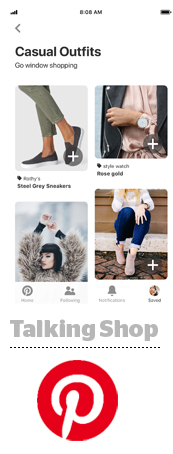
On Monday, Pinterest introed a tool to help retailers automatically ingest their online product catalogs as pins, including up-to-date pricing and stock info.
Advertisers can then take the additional step to promote their product pins as targeted shopping ads, which are now available via self-serve after a prolonged beta that started last year.
Similar functionality already exists on both Facebook and Instagram.
Although buy buttons didn’t really catch on when social media platforms started experimenting with shopping functionality four or five years ago, social commerce is starting to get real.
“Consumers aren’t looking to do that traditional path to purchase anymore – they go up and down and sideways before they land,” said Amy Vener, retail vertical strategy lead at Pinterest. “And there are lots of points of inspiration along that path.”
Although Pinterest declined to quantify the number of conversions being facilitated by its pixel, the company’s product development efforts over the last few years have focused on “pivoting that consumer inspiration into action,” she said.
The furniture retailer Room & Board, for example, saw 33 times the return on ad spend when it used the product during beta testing of Pinterest’s shopping ads. Room & Board gets the highest conversions using a combination of search and Pinterest, and customers who visit via Pinterest spend more on average per order than those who navigate from the web.
Being able to upload its online product feed makes it easier for shoppers to “find product details they need to make educated decisions,” said Ann Vick, Room & Board’s director of marketing.
Room & Board then drives its message home by retargeting shoppers on Pinterest, Vick said. In addition to the usual demographics-based targeting, Pinterest offers interest-based targeted parameters drawn from the types of things people pin and how they engage with pinned content.
But it’s Pinterest’s visual search technology, which uses algorithms to scan pinned images and make recommendations, that really helps drive purchase behavior on the platform, Vener said.
Most search is text based but there are hundreds of millions of visual searches conducted monthly on Pinterest, and visual discovery is a linchpin of Pinterest’s monetization strategy going forward, she said.
“We’ll continue using signals that include a visual element to make the experience more personalized,” Vener said. “And we’ll keep learning more about the surfaces and moments when inspiration turns into action, which retailers can use to drive sales.”
In addition to the catalog upload tool and self-serve shopping ads, Pinterest also rolled out a handful of other shopping-related features, including serving up pins for in-stock items in response to product searches and the ability to click on a pin and land directly at a retailer’s checkout.
This post was syndicated from Ad Exchanger.


More Stories
The NY Post Is Turning First-Party Data Into Direct Deals, With A Little Help From Its Friends
New board member for Blutui
Brave Commerce: Centering the Consumer in the CPG Industry